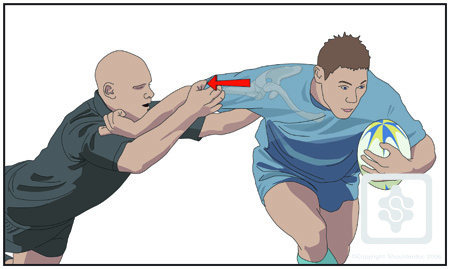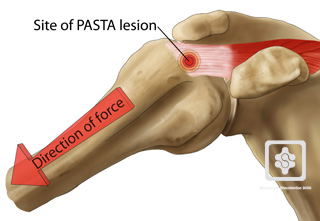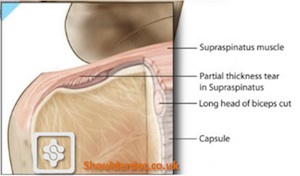PASTA Lesions
What is it?
PASTA stands for partial articular supraspinatus tendon avulsion.
If we look at each part individually, it gives us a better understanding as to what the lesion is.
- Partial: simply means the tear has not gone all the way through the tendon.
- Articular: There are two surfaces to the tendon. One is bursal and the other is articular. The articular surface is the inner-side of the tendon.
- Supraspinatus Tendon: This is one of the tendons which make up the rotator cuff, the group of muscles and tendons which help to move and stabilise the arm at the shoulder.
- Avulsion: An avulsion injury refers usually to a traumatic injury which has had some sort of pulling force applied.
So in summary, it is partial tear in one of the rotator cuff tendons of the shoulder (usually supraspinatus).
It is usually seen in athletes under the age of 45, as a result of a twisting and/or traction (pulling) injury of the shoulder.
It can present with pain when lifting outwards, overhead and throwing. Fatigue at the shoulder brought on by overhead activities is common.



When examined by a doctor, pain may be felt during the Empty Can (Jobe) Test (resisted abduction in the scapula plane) and/or the LaFosse test (resisted flexion with internal rotation with arm adducted across chest. The patient tries pushing against the doctor with the arm straight across the chest with the palm facing out.)
The tear may be seen on ultrasound scan or plain MRI scan. However, MRI scan or MR Arthrogram (where dye is injected into the joint beofre the scan) taken in a special position called the ABER (ABduction and External Rotation)position is more accurate. The ABER MRI scan is taken with the arm above the patients head in the scanner.
The best way to diagnose a PASTA lesion is at key-hole surgery (Arthroscopy).
Treatment
As with other forms of rotator cuff damage, it is possible to repair a PASTA lesion via a key-hole operation.
During the operation the patient is sat up in what is known as the beach chair position. First the camera is introduced into the joint via a small hole in the back of the shoulder. It is here where the PASTA lesion is identified. The tendon will appear frayed on the articular side. These frayed edges are debrided away using a shaving device. This provides clean edges for the repair. In some cases, this may be enough and a full cuff repair might not be necessary. The decision takes into account the size of the tear, the patient's age and the level of activity of the person.
If it is decided that a cuff repair is needed, then it can be done using the bone as a means of anchoring the tendon down.
For more information on Rotator Cuff Repair click here


